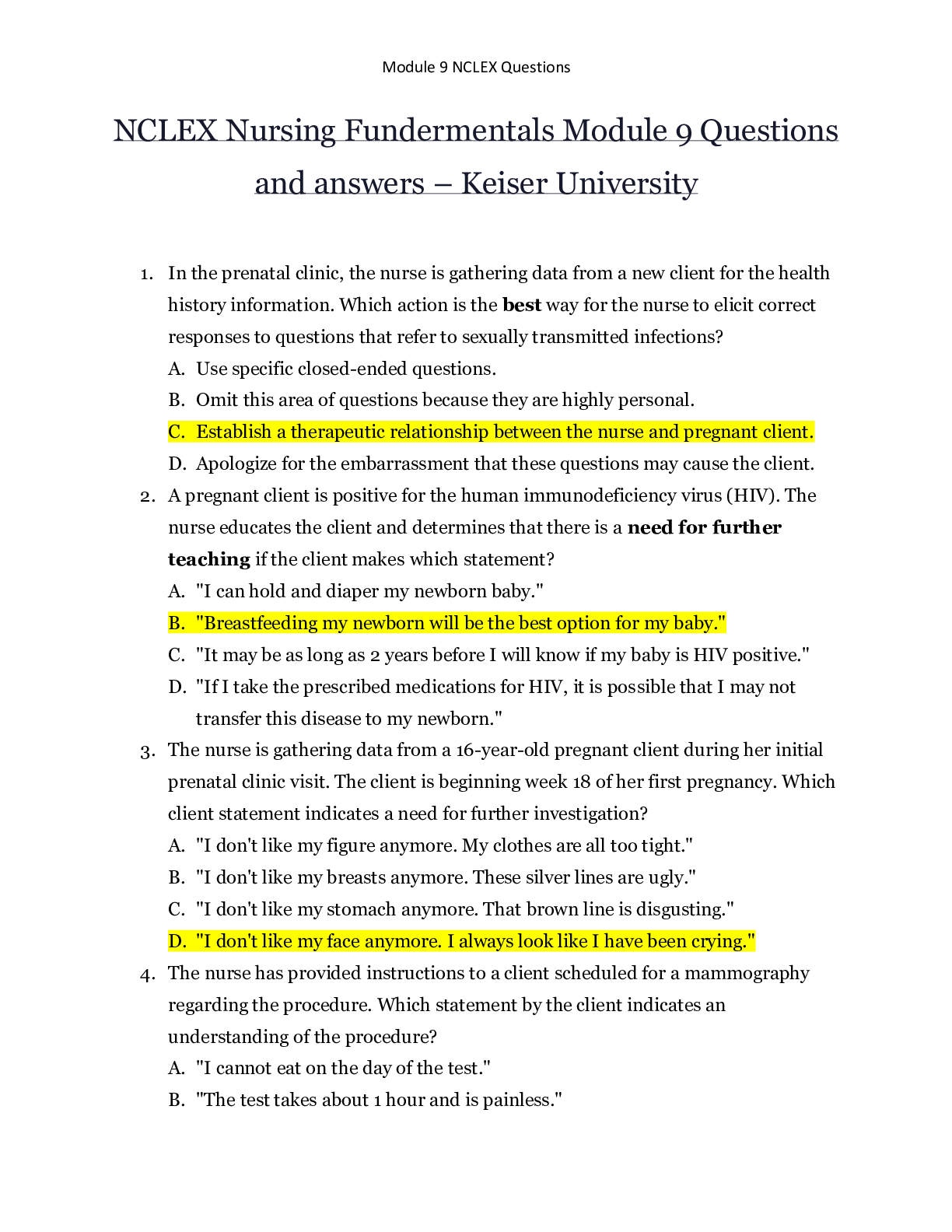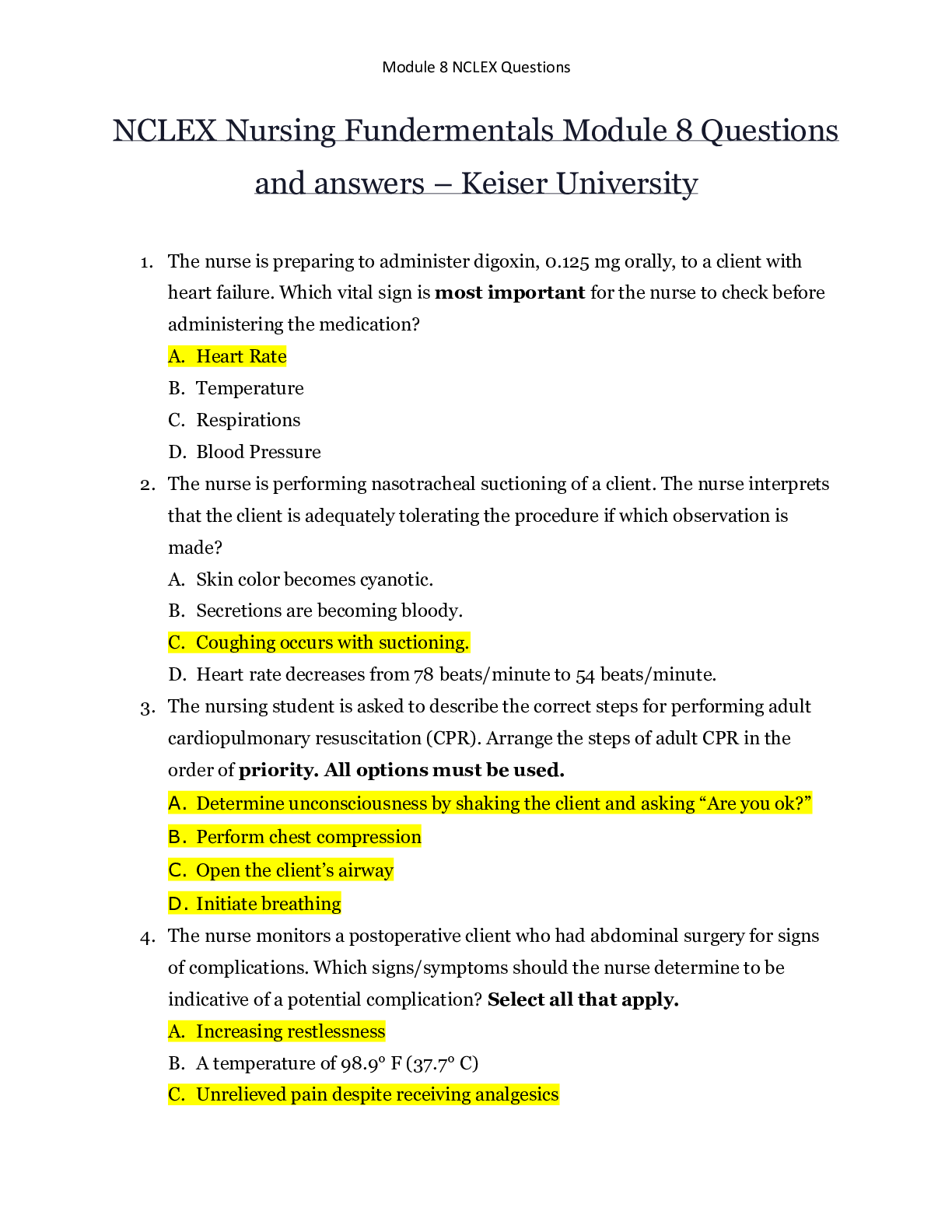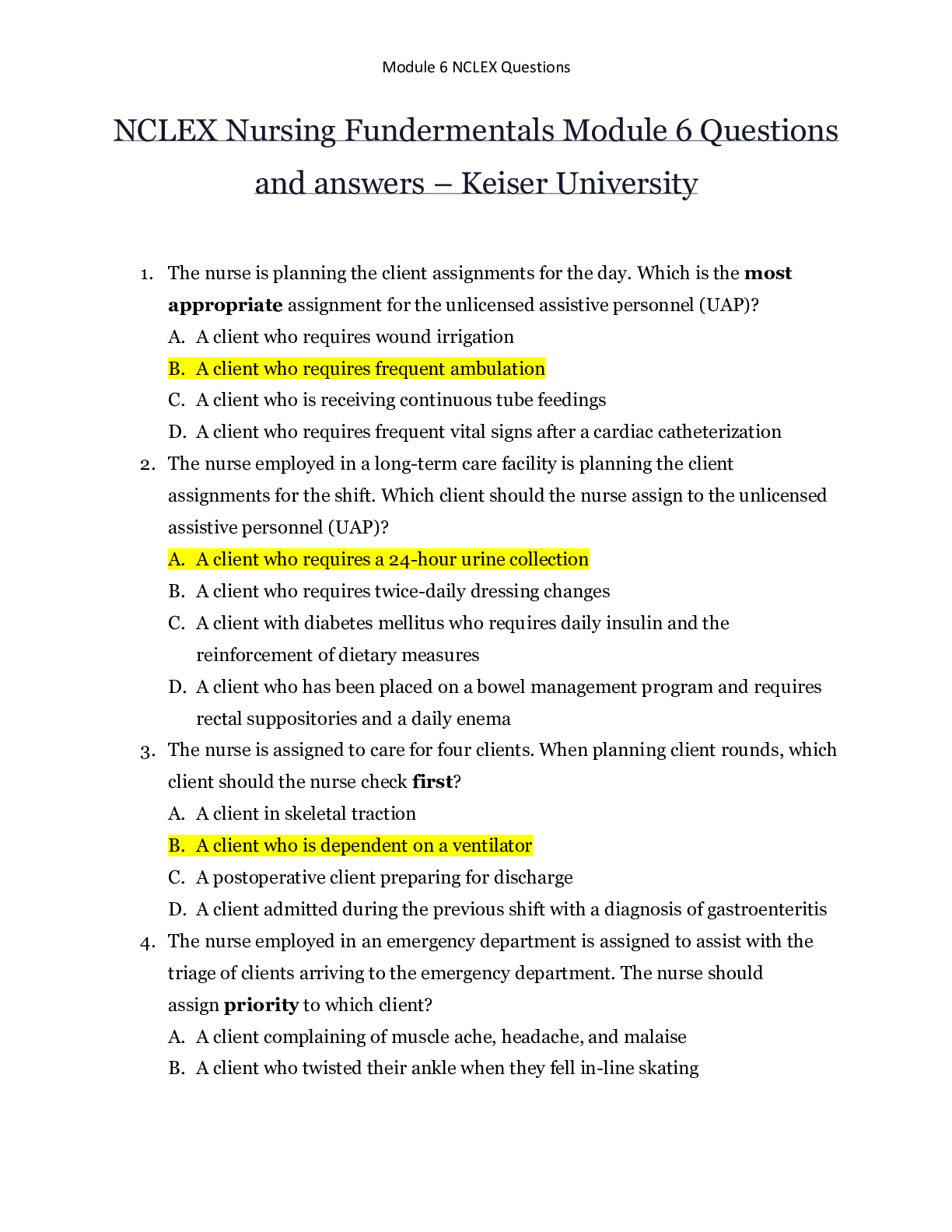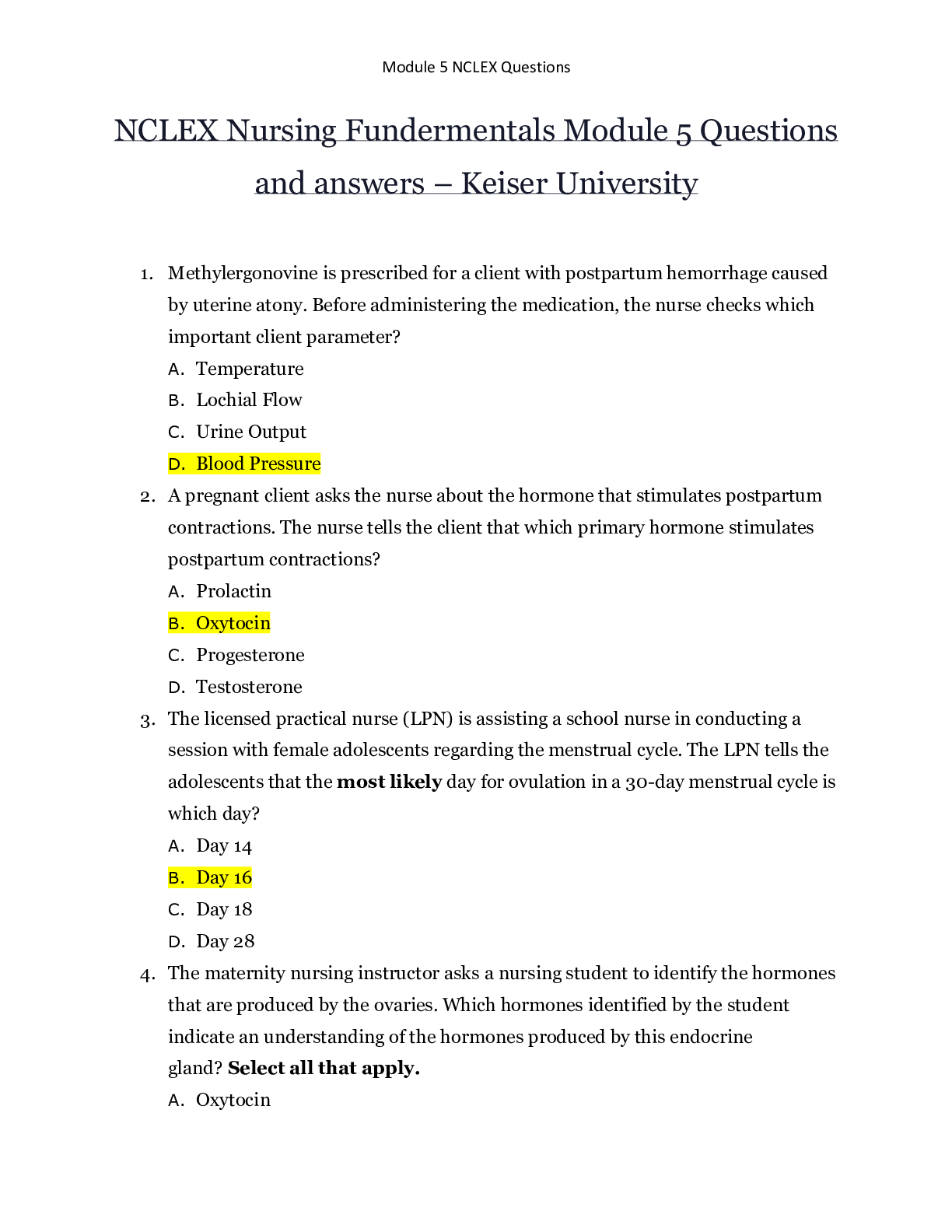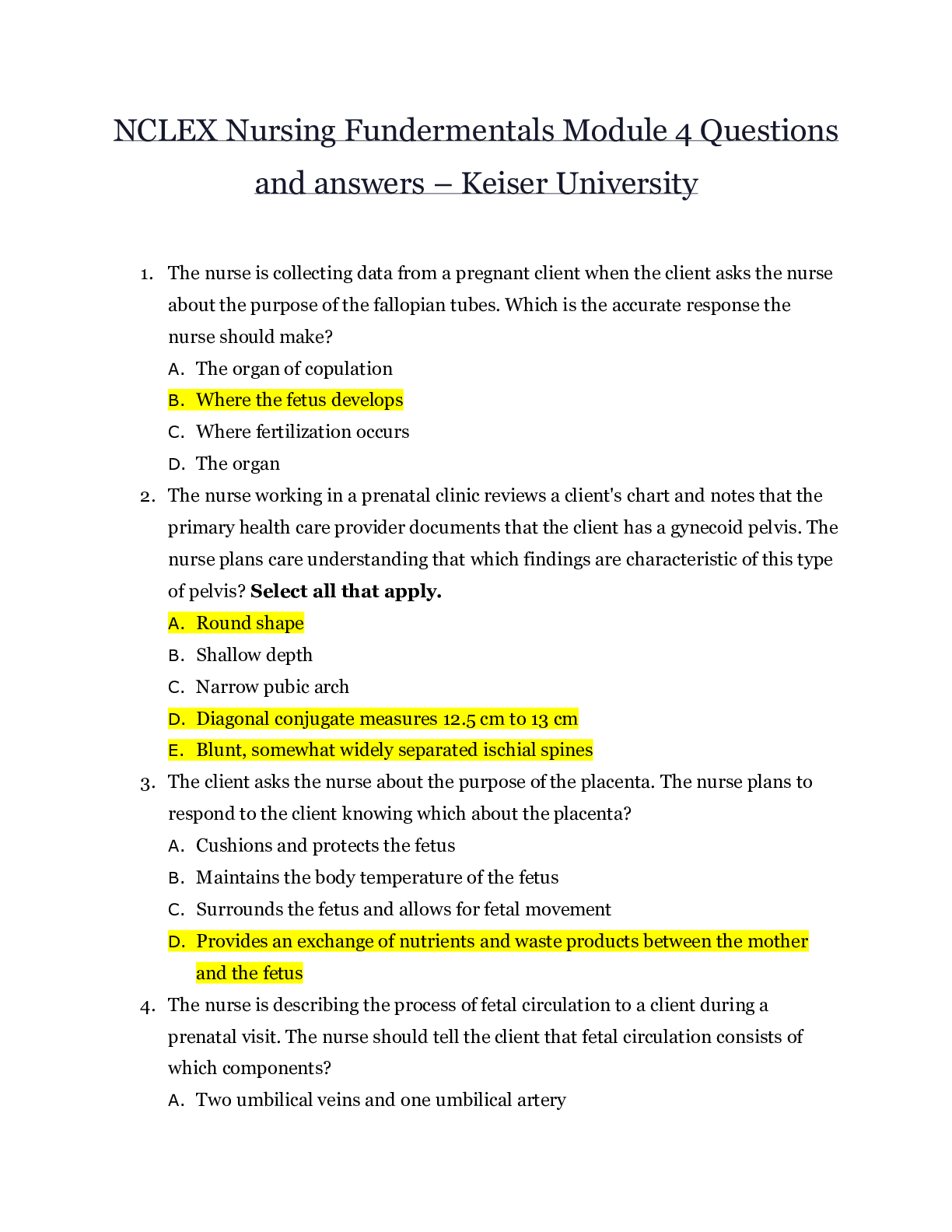Medical Studies > NCLEX-RN > Med Surg 2210 NCLEX TEST 1 WITH EXPLANATIONS | NCLEX QUESTION TRAINER EXPLANATIONS TEST 1 (All)
Med Surg 2210 NCLEX TEST 1 WITH EXPLANATIONS | NCLEX QUESTION TRAINER EXPLANATIONS TEST 1
Document Content and Description Below
NCLEX QUESTION TRAINER EXPLANATIONS 75+ Questions with answers and explanations TEST 1 1. The nurse is caring for clients in the outpatient clinic. Which of the following messages should the nurse... return FIRST? 1. A mother reports that the umbilical cord of her five-day-old infant is dry and hard to the touch. 2. A mother reports that the “soft spot” on the head of her four-day-old infant feels slightly elevated when the baby sleeps. 3. A mother reports that the circumcision of her 3-day-old infant is covered with yellowish exudate. 4. A father reports that he bumped the crib of his two-day-old infant and she violently extended her extremities and returned to them their previous position. Strategy: Determine the significance of each assessment and how it relates to a newborn. (1) expected outcome; falls off within 1-2 weeks; no tub baths until the cord falls off (2) correct–fontanelle should feel soft and flat; fullness or bulging indicates increased intracranial pressure (3) normal healing, don't remove exudate; clean with warm water (4) motor reflex is normal; disappears after 3-4 months 2. The parents of a child with hemophilia want to know the cause of the disease. Which of the following would be the BEST response by the nurse? 1. “The father transmits the gene to his son.” 2. “Both the mother and the father carry a recessive trait.” 3. “The mother transmits the gene to her son.” 4. “There is a 50% chance that the mother will pass the trait to each of her daughters.” Strategy: Think about each statement. Is it true? (1) affected male inherits gene from his mother and can transmit it only to his daughters (2) it is not an autosomal recessive trait (3) correct–hemophilia is a sex-linked disorder (4) there is a 50% chance that the mother will pass the trait to each of the childrenP R E P A R A T I O N F O R T H E N U R S I N G L I C E N S U R E E X A M I N A T I O N ................................................ 16 ........................................................................................................................................................................................................ Nursing 3. A six-month-old is brought to the clinic for a well-baby check-up. During the exam, the nurse should expect to assess which of the following? 1. A pincer grasp. 2. Sitting with support. 3. Tripling of the birth weight. 4. Presence of the posterior fontanelle. Strategy: Think about each answer. (1) present at nine months of age (2) correct–six-month-old should sit with help (3) present at one year (4) fontanelle is closed by two to three months 4. A 48-year-old man with an endotracheal tube needs suctioning. Which of the following statements is an accurate description of how the nurse should perform the procedure? 1. Insert the suction catheter four inches into the tube. Apply suction for 30 seconds, using a twirling motion as the catheter is withdrawn. 2. Hyperoxygenate the client and then insert the suction catheter into the tube. Suction while you remove the catheter using a back and forth motion. 3. Explain the procedure to the patient. Insert the catheter while gently applying suction, and withdraw using a twisting motion. 4. Insert the suction catheter until resistance is met, then withdraw it slightly. Apply suction intermittently as the catheter is withdrawn. Strategy: All answers are implementation. Determine the outcome of each answer. Is it desired? (1) catheter is inserted until resistance met; never suction longer than 10-15 sec (2) use twirling motion when withdrawing catheter (3) suction is never applied when catheter is inserted (4) correct–insert suction catheter until resistance is met without applying suction, withdraw 0.4-0.8 in (1-2 cm), apply intermittent suction with twirling motion 5. A 47-year-old woman comes to the outpatient psychiatric clinic for treatment of a fear of heights. The nurse knows that phobias involve 1. projection and displacement. 2. sublimation and internalization. 3. rationalization and intellectualization. 4. reaction formation and symbolization. Strategy: Think about each answer. (1) correct–projection (attributing one's thoughts or impulses to another) and displacement (shifting of emotion concerning person or object to another neutral or less dangerous object or person) (2) sublimation (diversion of unacceptable drives into socially acceptable channels) and internalization (incorporation of someone else's opinion as one's own) (3) rationalization (attempt to make behavior appear to be result of logical thinking), intellectualization (excessive reasoning or logic used to avoid experiencing disturbing feelings) (4) reaction formation (development of conscious attitudes and behavior patterns into opposite of what one really wants to do), symbolization (something represents something else); symbolization is involved in phobias............................................................................................................................ N C L E X Q U E S T I O N T R A I N E R Nursing ........................................................................................................................................................................................................ 17 6. The prenatal client at eight-weeks gestation has a positive VDRL. In preparing the teaching plan, which of the following would be MOST appropriate for the nurse to include? 1. The importance of not taking any medications so as not to damage the fetus. 2. Instructing the client on the importance of taking the penicillin for the prescribed time. 3. Instructing the client to refrain from sexual activity. 4. Maintaining the confidentiality of sexual partners or contacts. Strategy: Think "Maslow." (1) physical, true to some extent with regard to pregnant client not taking medication over-thecounter unless prescribed by a doctor, but not highest priority (2) correct–physical, vitally important to complete all the penicillin (3) physical, more important to be treated for disease (4) psychosocial, communicable diseases are reportable; partners or contacts need to be found and notified so they may be treated 7. An elderly client who has been recently immobilized is ordered to begin passive range-of-motion (ROM) exercises. What should the nurse understand about ROM before initiating this order? 1. Passive range-of-motion exercises increase muscle strength. 2. A full range of motion must be completed for the elderly client. 3. Exercises should be completed to the point of discomfort. 4. A sufficient range of motion assists the elderly to carry out activities of daily living (ADLs). Strategy: Think about each answer. (1) inaccurate statement (2) ROM may be limited (3) should not be done to point of discomfort (4) correct–full range of motion may not be needed or accomplished without discomfort for an elderly client; emphasis should be on ROMs that support ADLs 8. A 65-year-old man is scheduled for a colon resection this morning. Last night he had polyethylene glycolelectrolyte solution (GoLytely) and a soapsuds enema. This morning he passes a medium amount of soft, brown stool. The nurse should know that this 1. indicates that the bowel preparation is incomplete. 2. is evidence that the patient ate something after midnight. 3. is an expected finding before this type of surgery. 4. is the last stool that was left in the colon. Strategy: Think about each answer. (1) correct–colon should not have remaining soft stool (2) anything eaten after midnight would not appear as stool by the next morning (3) not expected; need to clean GI tract for surgery (4) assumption, not substantiated - - - - - - - - - - - - - - - - - - - - - - - - - -- - - - - - - - - - - - - 68. In preparing a teaching plan regarding colostomy irrigations, the nurse should include which of the following? 1. The colostomy needs to be irrigated at the same time every day. 2. Irrigate the colostomy after meals to increase peristalsis. 3. Insert the catheter about 10 inches into the stoma. 4. The solution should be very warm to increase dilation and flow. Strategy: All answers are implementation. Determine the outcome of each answer. Is it desired? (1) correct–colostomy irrigation should be done at same time each day to assist in establishing a normal pattern of elimination (2) colostomy should be irrigated only once a day (3) catheter should never be inserted more than 4 inches (4) solution should be at body temperature; increasing the temperature does not make irrigation more efficientP R E P A R A T I O N F O R T H E N U R S I N G L I C E N S U R E E X A M I N A T I O N ................................................ 38 ........................................................................................................................................................................................................ Nursing 69. The nurse knows which of the following would have the greatest impact on an elderly client’s ability to complete activities of daily living (ADLs)? 1. Perseveration. 2. Aphasia. 3. Mnemonic disturbance. 4. Apraxia. Strategy: Think about each answer. (1) speech disturbance, which would have the greatest impact on communication ability (2) speech disturbance, which would have the greatest impact on communication ability (3) speech disturbance, which would have the greatest impact on communication ability (4) correct–apraxia is loss of purposeful movement in the absence of motor or sensory impairment; when it affects an ADL, such as dressing, the client may not be able to put clothes on properly 70. Prior to sending a client for a cardiac catheterization, it would be MOST important for the nurse to report which of the following? 1. The client has an allergy to shellfish. 2. The client has diminished palpable peripheral pulses. 3. The client has cool lower extremities bilaterally. 4. The client is anxious about the pending procedure. Strategy: Think about the significance of each answer and how it relates to a cardiac catheterization. (1) correct–allergies to iodine and/or seafood must be reported immediately before a cardiac catheterization to avoid anaphylactic shock during the procedure (2) may be normal finding before the test (3) may be normal finding before the test (4) may be normal finding before the test 71. If a client has ataxia, the MOST important nursing action would be to 1. supervise ambulation. 2. measure the intake and output accurately. 3. consult the speech therapist. 4. elevate the foot of the bed. Strategy: Think about each answer. (1) correct–client's coordination is poor; the only relevant nursing action is to supervise ambulation (2) unnecessary (3) unnecessary (4) unnecessary............................................................................................................................ N C L E X Q U E S T I O N T R A I N E R Nursing ........................................................................................................................................................................................................ 39 72. A 14-year-old girl is brought to the hospital for treatment of second- and third-degree burns sustained in a house fire. An intravenous infusion is started in the patient’s left forearm. The nurse knows that the primary purpose of the IV is to 1. provide a route for pain medications. 2. maintain fluid balance. 3. prevent gastrointestinal upset. 4. obtain blood specimens for analysis. Strategy: Answers are implementation. Determine the outcome of each answer. Is it desired? (1) route used for pain medication to ensure absorption, but not primary purpose of IV (2) correct–loss of fluid occurs from open burn surfaces; maintaining circulation is life-saving requirement (3) threat of GI upset not primary importance; IV primary purpose to maintain fluid and electrolyte balance (4) peripheral IV not used for this purpose 73. An 80-year-old client is admitted with a possible fractured right hip. During the initial nursing assessment, which of the following observations of the right leg would validate or support this diagnosis? 1. The leg appears to be shortened and is abducted and externally rotated. 2. Plantar flexion is observed with sciatic pain radiating down the leg. 3. From the hip, the leg appears to be longer and is externally rotated. 4. There is evidence of paresis with decreased sensation and limited mobility. Strategy: Think about each symptom and how it relates to hip fracture. (1) correct–accurate assessments of the position of a fractured hip prior to repair (2) plantar flexion occurs with foot drop (3) leg would not appear to be longer (4) occurs with injury to the lumbar disc area 74. The nurse has collected the following data: client anger directed toward staff in the form of frequent sarcastic or crude comments, increased wringing of hands, and purposeless pacing, particularly after the client has used the telephone. Based on this data, the nurse should make which nursing diagnosis? 1. Impaired social interaction related to conversion reaction. 2. Risk for potential activity intolerance as evidenced by purposeless pacing. 3. Powerlessness in hospital situation. 4. Ineffective individual coping related to recent anger and anxiety. Strategy: Think about each answer. (1) not warranted with the data indicated (2) not warranted with the data indicated (3) not warranted with the data indicated (4) correct–client is displaying evidence of anger and anxiety and an inability to directly deal with concerns, which is ineffective copingP R E P A R A T I O N F O R T H E N U R S I N G L I C E N S U R E E X A M I N A T I O N ................................................ 40 ........................................................................................................................................................................................................ Nursing 75. The nursing team consists of a RN who has been practicing for six months, a LPN/LVN who has been practicing for 15 years, and a nursing assistant who has been caring for clients for three years. The RN should care for which of the following clients? 1. A client 1 day postop after an internal fixation of a fractured left femur. 2. A client receiving diltiazem (Cardizem) and phenytoin (Dilantin). 3. A client who is to receive 2 units of packed cells prior to an upper endoscopy procedure. 4. A client admitted yesterday with exhaustion and a diagnosis of acute bipolar disorder. Strategy: The RN cares for clients that require assessment, teaching, and nursing judgment. (1) care can be assigned to the nursing assistant; standard, unchanging procedure (2) medication can be given by the LPN (3) correct–requires the assessment and teaching skills of RN (4) offer food and fluids, assign to LPN [Show More]
Last updated: 1 year ago
Preview 1 out of 26 pages
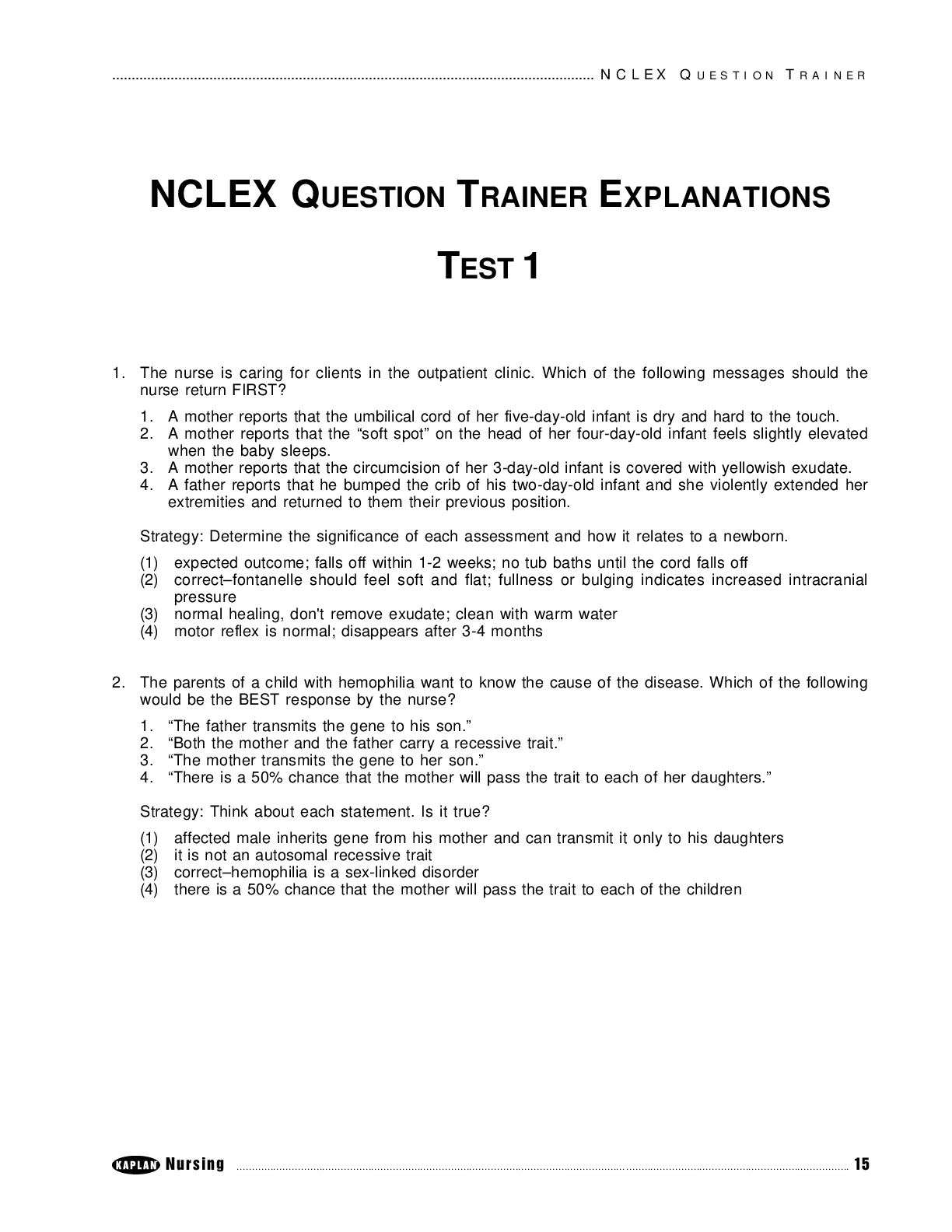
Buy this document to get the full access instantly
Instant Download Access after purchase
Add to cartInstant download
We Accept:

Reviews( 0 )
$14.50
Document information
Connected school, study & course
About the document
Uploaded On
Aug 04, 2020
Number of pages
26
Written in
Additional information
This document has been written for:
Uploaded
Aug 04, 2020
Downloads
0
Views
146

 - Florida International University.png)
 - Florida International University.png)
 - Florida International University.png)
 - Florida International University.png)


 Questions and answers – Keiser University.png)
